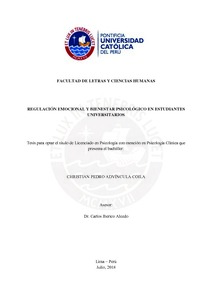| dc.contributor.advisor | Iberico Alcedo, Carlos Simón | es_ES |
| dc.contributor.author | Advíncula Coila, Christian Pedro | es_ES |
| dc.date.accessioned | 2018-09-17T20:30:21Z | es_ES |
| dc.date.available | 2018-09-17T20:30:21Z | es_ES |
| dc.date.created | 2018 | es_ES |
| dc.date.issued | 2018-09-17 | es_ES |
| dc.identifier.uri | http://hdl.handle.net/20.500.12404/12666 | |
| dc.description.abstract | Actualmente los estudiantes universitarios deben desarrollar diversas actividades académicas
que conlleva un gran esfuerzo emocional, frente a ello necesitan regular las emociones con la
finalidad de cuidar su bienestar. La presente investigación tiene como objetivo principal
examinar la relación entre las estrategias de regulación emocional y el bienestar psicológico
(global y sus 6 dimensiones) en estudiantes universitarios. Además, de manera específica
conocer cuál es el nivel de bienestar psicológico y qué estrategias de regulación utilizan
predominantemente los estudiantes (reevaluación cognitiva y/o supresión). Por último,
examinar si existe diferencia por sexo biológico en las variables principales. La muestra estuvo
conformada por 101 estudiantes, entre 16 y 25 años de edad; se utilizaron dos instrumentos: el
Cuestionario de autorregulación emocional (ERQP) y la Escala de bienestar psicológico de
Ryff; ambos instrumentos se encuentran adaptados al contexto peruano. Entre los resultados,
se obtuvo correlaciones significativas entre la regulación emocional y el bienestar psicológico;
también, se obtuvo correlaciones significativas entre los tipos de regulación emocional y las
sub-escalas de bienestar psicológico. Finalmente, se hallaron diferencias por sexo biológico en
la subescala de Autonomía. Los estudiantes desarrollan las mismas capacidades en la
regulación de las emociones y el bienestar que experimentan. | es_ES |
| dc.description.abstract | Currently university students should develop various academic activities that carry a great
emotional effort, whereupon they need to regulate emotions to look after their well-being. The
present research has as main objective to examine the relationship between the strategies of
Emotional Regulation and the psychological well-being (global and its 6 dimensions) in
university students. In addition, specifically to know the level of psychological well-being and
what regulatory strategies predominantly use students (cognitive reevaluation and/or
suppression). Finally, examine whether there is gender difference in the main variables. The
sample consisted of 101 students, between 16 and 25 years old; two instruments were used:
Emotional Self-Regulation Questionnaire (ERQP) and Ryff’s scale of Psychological Wellbeing;
both instruments are adapted to the Peruvian context. Among the results, significant
correlations between emotional control and psychological well-being were obtained. Also,
significant correlations between the types of emotional regulation and Ryff’s subscales of
Psychological Well-being were obtained; gender differences were found in the subscale of
Autonomy. Students develop the same abilities in regulating emotions and well experienced. | es_ES |
| dc.language.iso | spa | es_ES |
| dc.publisher | Pontificia Universidad Católica del Perú | es_ES |
| dc.rights | info:eu-repo/semantics/openAccess | es_ES |
| dc.rights.uri | http://creativecommons.org/licenses/by/2.5/pe/ | * |
| dc.subject | Bienestar | es_ES |
| dc.subject | Emociones | es_ES |
| dc.subject | Estudiantes universitarios--Investigaciones | es_ES |
| dc.title | Regulación emocional y bienestar psicológico en estudiantes universitarios | es_ES |
| dc.type | info:eu-repo/semantics/bachelorThesis | es_ES |
| thesis.degree.name | Licenciado en Psicología Clínica | es_ES |
| thesis.degree.level | Título Profesional | es_ES |
| thesis.degree.grantor | Pontificia Universidad Católica del Perú. Facultad de Letras y Ciencias Humanas | es_ES |
| thesis.degree.discipline | Psicología Clínica | es_ES |
| renati.discipline | 313026 | es_ES |
| renati.level | https://purl.org/pe-repo/renati/level#tituloProfesional | es_ES |
| renati.type | http://purl.org/pe-repo/renati/type#tesis | es_ES |
| dc.publisher.country | PE | es_ES |
| dc.subject.ocde | https://purl.org/pe-repo/ocde/ford#5.01.00 | es_ES |






